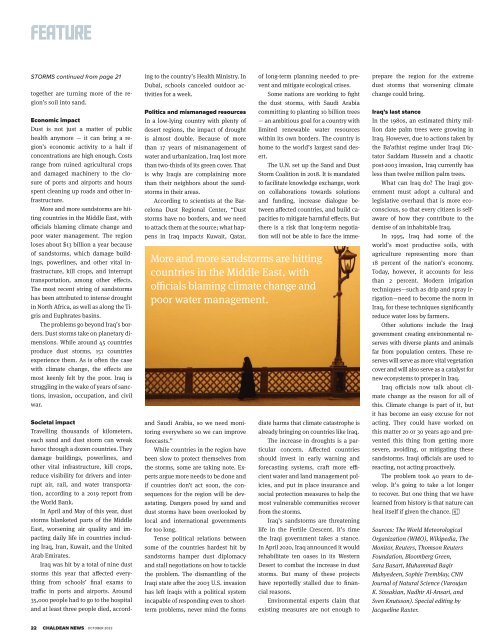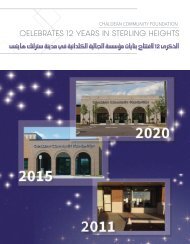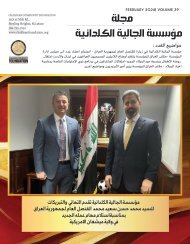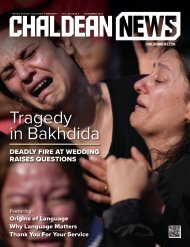Create successful ePaper yourself
Turn your PDF publications into a flip-book with our unique Google optimized e-Paper software.
FEATURE<br />
STORMS continued from page 21<br />
together are turning more of the region’s<br />
soil into sand.<br />
Economic impact<br />
Dust is not just a matter of public<br />
health anymore — it can bring a region’s<br />
economic activity to a halt if<br />
concentrations are high enough. Costs<br />
range from ruined agricultural crops<br />
and damaged machinery to the closure<br />
of ports and airports and hours<br />
spent cleaning up roads and other infrastructure.<br />
More and more sandstorms are hitting<br />
countries in the Middle East, with<br />
officials blaming climate change and<br />
poor water management. The region<br />
loses about $13 billion a year because<br />
of sandstorms, which damage buildings,<br />
powerlines, and other vital infrastructure,<br />
kill crops, and interrupt<br />
transportation, among other effects.<br />
The most recent string of sandstorms<br />
has been attributed to intense drought<br />
in North Africa, as well as along the Tigris<br />
and Euphrates basins.<br />
The problems go beyond Iraq’s borders.<br />
Dust storms take on planetary dimensions.<br />
While around 45 countries<br />
produce dust storms, 151 countries<br />
experience them. As is often the case<br />
with climate change, the effects are<br />
most keenly felt by the poor. Iraq is<br />
struggling in the wake of years of sanctions,<br />
invasion, occupation, and civil<br />
war.<br />
Societal impact<br />
Travelling thousands of kilometers,<br />
each sand and dust storm can wreak<br />
havoc through a dozen countries. They<br />
damage buildings, powerlines, and<br />
other vital infrastructure, kill crops,<br />
reduce visibility for drivers and interrupt<br />
air, rail, and water transportation,<br />
according to a 2019 report from<br />
the World Bank.<br />
In April and May of this year, dust<br />
storms blanketed parts of the Middle<br />
East, worsening air quality and impacting<br />
daily life in countries including<br />
Iraq, Iran, Kuwait, and the United<br />
Arab Emirates.<br />
Iraq was hit by a total of nine dust<br />
storms this year that affected everything<br />
from schools’ final exams to<br />
traffic in ports and airports. Around<br />
35,000 people had to go to the hospital<br />
and at least three people died, according<br />
to the country’s Health Ministry. In<br />
Dubai, schools canceled outdoor activities<br />
for a week.<br />
Politics and mismanaged resources<br />
In a low-lying country with plenty of<br />
desert regions, the impact of drought<br />
is almost double. Because of more<br />
than 17 years of mismanagement of<br />
water and urbanization, Iraq lost more<br />
than two-thirds of its green cover. That<br />
is why Iraqis are complaining more<br />
than their neighbors about the sandstorms<br />
in their areas.<br />
According to scientists at the Barcelona<br />
Dust Regional Center, “Dust<br />
storms have no borders, and we need<br />
to attack them at the source; what happens<br />
in Iraq impacts Kuwait, Qatar,<br />
and Saudi Arabia, so we need monitoring<br />
everywhere so we can improve<br />
forecasts.”<br />
While countries in the region have<br />
been slow to protect themselves from<br />
the storms, some are taking note. Experts<br />
argue more needs to be done and<br />
if countries don’t act soon, the consequences<br />
for the region will be devastating.<br />
Dangers posed by sand and<br />
dust storms have been overlooked by<br />
local and international governments<br />
for too long.<br />
Tense political relations between<br />
some of the countries hardest hit by<br />
sandstorms hamper dust diplomacy<br />
and stall negotiations on how to tackle<br />
the problem. The dismantling of the<br />
Iraqi state after the 2003 U.S. invasion<br />
has left Iraqis with a political system<br />
incapable of responding even to shortterm<br />
problems, never mind the forms<br />
More and more sandstorms are hitting<br />
countries in the Middle East, with<br />
officials blaming climate change and<br />
poor water management.<br />
of long-term planning needed to prevent<br />
and mitigate ecological crises.<br />
Some nations are working to fight<br />
the dust storms, with Saudi Arabia<br />
committing to planting 10 billion trees<br />
— an ambitious goal for a country with<br />
limited renewable water resources<br />
within its own borders. The country is<br />
home to the world’s largest sand desert.<br />
The U.N. set up the Sand and Dust<br />
Storm Coalition in 2018. It is mandated<br />
to facilitate knowledge exchange, work<br />
on collaborations towards solutions<br />
and funding, increase dialogue between<br />
affected countries, and build capacities<br />
to mitigate harmful effects. But<br />
there is a risk that long-term negotiation<br />
will not be able to face the immediate<br />
harms that climate catastrophe is<br />
already bringing on countries like Iraq.<br />
The increase in droughts is a particular<br />
concern. Affected countries<br />
should invest in early warning and<br />
forecasting systems, craft more efficient<br />
water and land management policies,<br />
and put in place insurance and<br />
social protection measures to help the<br />
most vulnerable communities recover<br />
from the storms.<br />
Iraq’s sandstorms are threatening<br />
life in the Fertile Crescent. It’s time<br />
the Iraqi government takes a stance.<br />
In April 2020, Iraq announced it would<br />
rehabilitate ten oases in its Western<br />
Desert to combat the increase in dust<br />
storms. But many of these projects<br />
have reportedly stalled due to financial<br />
reasons.<br />
Environmental experts claim that<br />
existing measures are not enough to<br />
prepare the region for the extreme<br />
dust storms that worsening climate<br />
change could bring.<br />
Iraq’s last stance<br />
In the 1980s, an estimated thirty million<br />
date palm trees were growing in<br />
Iraq. However, due to actions taken by<br />
the Ba’athist regime under Iraqi Dictator<br />
Saddam Hussein and a chaotic<br />
post-2003 invasion, Iraq currently has<br />
less than twelve million palm trees.<br />
What can Iraq do? The Iraqi government<br />
must adopt a cultural and<br />
legislative overhaul that is more ecoconscious,<br />
so that every citizen is selfaware<br />
of how they contribute to the<br />
demise of an inhabitable Iraq.<br />
In 1995, Iraq had some of the<br />
world’s most productive soils, with<br />
agriculture representing more than<br />
18 percent of the nation’s economy.<br />
Today, however, it accounts for less<br />
than 2 percent. Modern irrigation<br />
techniques—such as drip and spray irrigation—need<br />
to become the norm in<br />
Iraq, for these techniques significantly<br />
reduce water loss by farmers.<br />
Other solutions include the Iraqi<br />
government creating environmental reserves<br />
with diverse plants and animals<br />
far from population centers. These reserves<br />
will serve as more vital vegetation<br />
cover and will also serve as a catalyst for<br />
new ecosystems to prosper in Iraq.<br />
Iraq officials now talk about climate<br />
change as the reason for all of<br />
this. Climate change is part of it, but<br />
it has become an easy excuse for not<br />
acting. They could have worked on<br />
this matter 20 or 30 years ago and prevented<br />
this thing from getting more<br />
severe, avoiding, or mitigating these<br />
sandstorms. Iraqi officials are used to<br />
reacting, not acting proactively.<br />
The problem took 40 years to develop.<br />
It’s going to take a lot longer<br />
to recover. But one thing that we have<br />
learned from history is that nature can<br />
heal itself if given the chance.<br />
Sources: The World Meteorological<br />
Organization (WMO), Wikipedia, The<br />
Monitor, Reuters, Thomson Reuters<br />
Foundation, Bloomberg Green,<br />
Sara Basart, Muhammad Baqir<br />
Muhyedeen, Sophie Tremblay, CNN<br />
Journal of Natural Science (Varoujan<br />
K. Sissakian, Nadhir Al-Ansari, and<br />
Sven Knutsson). Special editing by<br />
Jacqueline Raxter.<br />
22 CHALDEAN NEWS <strong>OCTOBER</strong> <strong>2022</strong>

















